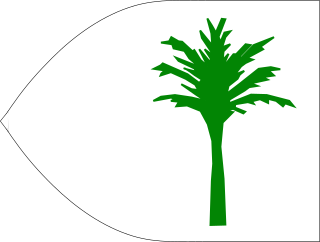
The Kanem–Bornu Empire existed in areas which are now part of Nigeria, Niger, Cameroon and Chad. It was known to the Arabian geographers as the Kanem Empire from the 8th century AD onward and lasted as the independent kingdom of Bornu until 1900.
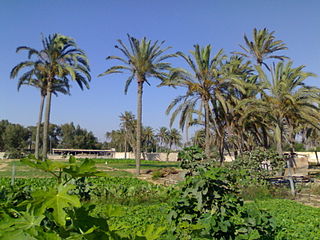
Awjila is an oasis town in the Al Wahat District in the Cyrenaica region of northeastern Libya. Since classical times it has been known as a place where high quality dates are farmed. From the Arab conquest in the 7th century, Islam has played an important role in the community. The oasis is located on the east-west caravan route between Egypt and Tripoli, Libya, and on the north-south route between Benghazi and the Sahel between Lake Chad and Darfur, and in the past was an important trading center. It is the place after which the Awjila language, an Eastern Berber language, is named. The people cultivate small gardens using water from deep wells. Recently, the oil industry has become an increasingly important source of employment.

Central Africa is a subregion of the African continent comprising various countries according to different definitions. Angola, Burundi, the Central African Republic, Chad, the Democratic Republic of the Congo, the Republic of the Congo, Equatorial Guinea, Gabon, Rwanda, and São Tomé and Príncipe are members of the Economic Community of Central African States (ECCAS). Six of those states are also members of the Economic and Monetary Community of Central Africa (CEMAC) and share a common currency, the Central African CFA franc.

Gustav Nachtigal was a German military surgeon and explorer of Central and West Africa. He is further known as the German Empire's consul-general for Tunisia and Commissioner for West Africa. His mission as commissioner resulted in Togoland and Kamerun becoming the first colonies of a German colonial empire. The Gustav-Nachtigal-Medal, awarded by the Berlin Geographical Society, is named after him.

Eduard Vogel was a German explorer in Central Africa.

The Sultanate or Kingdom of Bagirmi or Baghermi was a kingdom and Islamic sultanate southeast of Lake Chad in central Africa. It was founded in either 1480 or 1522 and lasted until 1897, when it became a French protectorate. Its capital was Massenya, north of the Chari River and close to the border to modern Cameroon. The kings wore the title Mbang.
Baguirmi is a department of Chad, one of three in the Chari-Baguirmi Region. It takes its name from the kingdom of Baguirmi. Its capital is Massenya.

The Wadai Sultanate was an African sultanate located to the east of Lake Chad in present-day Chad and the Central African Republic. It emerged in the seventeenth century under the leadership of the first sultan, Abd al-Karim, who overthrew the ruling Tunjur people of the area. It occupied land previously held by the Sultanate of Darfur to the northeast of the Sultanate of Baguirmi.
Sungor (Assangori) is a language of eastern Chad and western Sudan. It is spoken in an area located to the south of Biltine and to the north of Adré in Chad.
The Tunjur people are a Sunni Muslim ethnic group living in eastern Chad and western Sudan. In the 21st century, their number has been estimated at 175.000 people.
The Maba, Burgu or Bargo people are a minority ethnic group found primarily in the mountainous Ouaddaï region of eastern Chad and adjacent areas of Sudan. Their population is estimated to be about 300,000 in Chad. Other estimates place the total number of Burgu people in Sudan to be about 700,000.
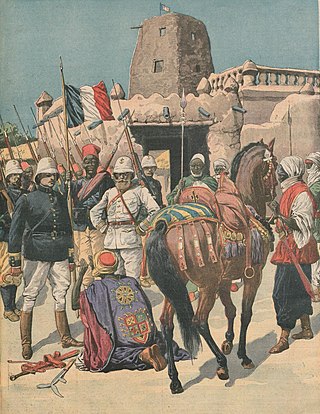
The Wadai War was waged by France and its African allies against the Wadai Empire and its allies from 1906 to 1912. Located in what today would be eastern Chad and western Sudan, Wadai fiercely resisted the French invasion. Regardless, much of Wadai including its capital Abéché fell to the invaders in 1909, forcing the empire's ruler Dud Murra to continue his resistance from outlying provinces and allied states. He managed to gain the support of the Sultanate of Darfur and Dar Masalit, and used these areas as rear bases during his attempts to oust the French. Doing so, he enjoyed some success, and inflicted several defeats on French-led forces. In order to legitimize their intervention, the French installed Dud Murra's relative Adam Asil as puppet ruler in Wadai. After losing most of his forces and allies, Dud Murra was forced to surrender in 1911. Regardless, unrest initially continued: a major anti-French revolt broke out soon after Dud Murra's defeat, and an anti-European conspiracy was allegedly organized with the support of Adam Asil. The last effective anti-French resistance in Wadai was suppressed by 1912 and the region remained a part of French colonial empire until 1960.
Tama are a non-Arab, African ethnic group of people who live in eastern Chad and western Sudan. They speak Tama, a Nilo-Saharan language. The population is 200,000–300,000 people and they practice Islam. Many Tama are subsistence farmers who live in permanent settlements and some raise livestock. In the civil war in Chad (2005–2010) the Tama were involved in ethnic conflicts with the Zaghawa tribe.
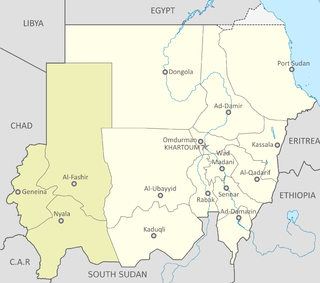
Throughout its history, Darfur has been the home to several cultures and kingdoms, like the mythical Tora or the Daju and Tunjur kingdoms. The recorded history of Darfur begins in the seventeenth century, with the foundation of the Fur Sultanate by the Keira dynasty. In 1875, the Anglo-Egyptian Co-dominion in Khartoum ended the dynasty. The British allowed Darfur a measure of autonomy until formal annexation in 1916. However, the region remained underdeveloped through the period of colonial rule and after independence in 1956. The majority of national resources were directed toward the riverine Arabs clustered along the Nile near Khartoum. This pattern of structural inequality and overly underdevelopment resulted in increasing restiveness among Darfuris. The influence of regional geopolitics and war by proxy, coupled with economic hardship and environmental degradation, from soon after independence led to sporadic armed resistance from the mid-1980s. The continued violence culminated in an armed resistance movement around 2003.
The Daju people are a group of seven distinct ethnicities speaking related languages living on both sides of the Chad-Sudan border and in the Nuba Mountains. Separated by distance and speaking different languages, at present, they generally have little cultural affinity to each other.

The Sultanate of Darfur was a pre-colonial state in present-day Sudan. It existed from 1603 to October 24, 1874, when it fell to the Sudanese warlord Rabih az-Zubayr and again from 1898 to 1916, when it was conquered by the British and integrated into Anglo-Egyptian Sudan. At its peak in the late 18th and early 19th century it stretched all the way from Darfur in the west to Kordofan and the western banks of the White Nile in the east, giving it the size of present-day Nigeria.
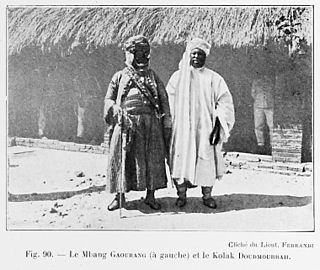
Muhammad Salih bin Yusuf, known as Dud Murra or Dudmurrah, was the last independent ruler, or kolak, of the Wadai Empire. He allied with the Sanusi, powerful traders of the eastern Sahara, and with the Sultan of Darfur to resist French aggression in the eastern Sahel, but was defeated. His sultanate was incorporated in the French military territory of Chad.
The Tunjur kingdom was a Sahelian precolonial kingdom in Africa between the 15th and early 17th centuries.

Dar al Kuti was an Islamic state in the center and northwest of the present Central African Republic which existed from around 1830 until 17 December 1912. From around 1800 the name Dar al-Kuti was given to a stretch of the frontier to the southwest of Wadai, a sultanate in the region of Lake Chad. The term "dar" signifies "abode" in Arabic, while the term "kuti" in the local language denotes a forest or densely-wooded area.












